Experimental Investigation of Impactor Diameter Effect on Low-Velocity Impact Response of CFRP Laminates in a Drop-Weight Impact Event
Abstract
1. Introduction
2. Materials and Methods
2.1. Specimen Preparation
2.2. Low-Velocity Impact Testing
2.3. Phased Array Ultrasonic Testing
3. Results and Discussion
3.1. Damage Response Parameters
3.1.1. Impact Force-Time History
3.1.2. Impact Force-Displacement Response
3.1.3. Absorbed Energy
3.2. Impact Damage at Surface
3.3. Ultrasonic Inspection Results
3.3.1. Ultrasonic C-Scans
3.3.2. Ultrasonic S-Scans
4. Conclusions
- The impactor diameters significantly affects the impact damage states in the low velocity impact event, both on the impact response parameters and damage characteristics. For the same impact energy, the absorbed energy and final displacement increases with the increase in impactor diameter.
- The dent depth decreases with the increase of impactor diameters. For small impactor diameter, visual impact damage at the front surface is more serious than the large one under equienergetic impact, as well as the back surface.
- For the lower impact energy (7 J and 17 J), the damage area are nearly the same with the three impact diameters, while at the higher energy level (27 J) it increases as the impactor diameter increases.
- The dent depth and damage area has a negative relationship for the 27 J impact energy with different impactor diameters, while has no obvious correlation for lower impact energies.
- The extension shape of the internal damage is slightly related to impactor diameter and only linked to the impact energy. With the increase in the impact energy, the damage shape varies from frustum-cone to pine-tree. For all impactor diameters, the critical delamination at large impact energy is underneath the middle of the laminate as impacted by the interaction between interlaminar stresses and bending stress.
Author Contributions
Funding
Conflicts of Interest
References
- Razali, N.; Sultan, M.; Mustapha, F.; Yidris, N.; Ishak, M. Impact damage on composite structures—A review. Int. J. Eng. Sci. 2014, 3, 8–20. [Google Scholar]
- Agrawal, S.; Singh, K.K.; Sarkar, P.K. Impact damage on fibre-reinforced polymer matrix composite—A review. J. Compos. Mater. 2013, 48, 317–332. [Google Scholar] [CrossRef]
- Shyr, T.-W.; Pan, Y.-H. Impact resistance and damage characteristics of composite laminates. Compos. Struct. 2003, 62, 193–203. [Google Scholar] [CrossRef]
- Tan, R.; Xu, J.; Sun, W.; Liu, Z.; Guan, Z.; Guo, X. Relationship Between Matrix Cracking and Delamination in CFRP Cross-Ply Laminates Subjected to Low Velocity Impact. Materials 2019, 12, 3990. [Google Scholar] [CrossRef] [PubMed]
- Panettieri, E.; Fanteria, D.; Montemurro, M.; Froustey, C. Low-velocity impact tests on carbon/epoxy composite laminates: A benchmark study. Compos. Part B Eng. 2016, 107, 9–21. [Google Scholar] [CrossRef]
- Richardson, M.; Wisheart, M. Review of low-velocity impact properties of composite materials. Compos. Part A Appl. Sci. Manuf. 1996, 27, 1123–1131. [Google Scholar] [CrossRef]
- Li, H.; Zhang, Q.; Jia, J.; Ji, C.; Wang, B.; Yan, S. Study on Low-Velocity Impact Damage and Residual Strength of Reinforced Composite Skin Structure. Materials 2020, 13, 2573. [Google Scholar] [CrossRef]
- Leng, J.; Guo, T.; Yang, M.; Guo, Z.; Fang, Z.; Liu, Z.; Li, D.; Sun, D. Analysis of Low-Velocity Impact Resistance of Carbon Fiber Reinforced Polymer Composites Based on the Content of Incorporated Graphite Fluoride. Materials 2020, 13, 187. [Google Scholar] [CrossRef]
- Caminero, M.A.; García-Moreno, I.; Rodríguez, G.P.; Chacón, J.M. Internal damage evaluation of composite structures using phased array ultrasonic technique: Impact damage assessment in CFRP and 3D printed reinforced composites. Compos. Part B Eng. 2019, 165, 131–142. [Google Scholar] [CrossRef]
- Meola, C.; Boccardi, S.; Carlomagno, G.M.; Boffa, N.D.; Monaco, E.; Ricci, F. Nondestructive evaluation of carbon fibre reinforced composites with infrared thermography and ultrasonics. Compos. Struct. 2015, 134, 845–853. [Google Scholar] [CrossRef]
- Blandford, B.M.; Jack, D.A. High resolution depth and area measurements of low velocity impact damage in carbon fiber laminates via an ultrasonic technique. Compos. Part B Eng. 2020, 188, 107843. [Google Scholar] [CrossRef]
- Wronkowicz, A.; Dragan, K.; Lis, K. Assessment of uncertainty in damage evaluation by ultrasonic testing of composite structures. Compos. Struct. 2018, 203, 71–84. [Google Scholar] [CrossRef]
- Ryuzono, K.; Yashiro, S.; Nagai, H.; Toyama, N. Topology Optimization-Based Damage Identification Using Visualized Ultrasonic Wave Propagation. Materials 2019, 13, 33. [Google Scholar] [CrossRef] [PubMed]
- Meola, C.; Boccardi, S.; Carlomagno, G.M.; Boffa, N.D.; Ricci, F.; Simeoli, G.; Russo, P. Impact damaging of composites through online monitoring and non-destructive evaluation with infrared thermography. NDT E Int. 2017, 85, 34–42. [Google Scholar] [CrossRef]
- Saeedifar, M.; Mansvelder, J.; Mohammadi, R.; Zarouchas, D. Using passive and active acoustic methods for impact damage assessment of composite structures. Compos. Struct. 2019, 226, 111252. [Google Scholar] [CrossRef]
- Saeedifar, M.; Najafabadi, M.A.; Zarouchas, D.; Toudeshky, H.H.; Jalalvand, M. Barely visible impact damage assessment in laminated composites using acoustic emission. Compos. Part B Eng. 2018, 152, 180–192. [Google Scholar] [CrossRef]
- Gholizadeh, S. A review of non-destructive testing methods of composite materials. Procedia Struct. Integr. 2016, 1, 50–57. [Google Scholar] [CrossRef]
- Gaudenzi, P.; Bernabei, M.; Dati, E.; De Angelis, G.; Marrone, M.; Lampani, L. On the evaluation of impact damage on composite materials by comparing different NDI techniques. Compos. Struct. 2014, 118, 257–266. [Google Scholar] [CrossRef]
- Sadeghi, M.Z.; Nienheysen, P.; Arslan, S.; Dafnis, A.; Silva Marció, B.; Schmitt, R.H.; Schröder, K.U. Damage detection by double-sided ultrasonic assessment in low-velocity impacted CFRP plates. Compos. Struct. 2019, 208, 646–655. [Google Scholar] [CrossRef]
- Mitrevski, T.; Marshall, I.H.; Thomson, R.; Jones, R.; Whittingham, B. The effect of impactor shape on the impact response of composite laminates. Compos. Struct. 2005, 67, 139–148. [Google Scholar] [CrossRef]
- Mitrevski, T.; Marshall, I.H.; Thomson, R. The influence of impactor shape on the damage to composite laminates. Compos. Struct. 2006, 76, 116–122. [Google Scholar] [CrossRef]
- Slawski, S.; Szymiczek, M.; Kaczmarczyk, J.; Domin, J.; Switonski, E. Low Velocity Impact Response and Tensile Strength of Epoxy Composites with Different Reinforcing Materials. Materials 2020, 13, 3059. [Google Scholar] [CrossRef] [PubMed]
- Sławski, S.; Szymiczek, M.; Kaczmarczyk, J.; Domin, J.; Duda, S. Experimental and Numerical Investigation of Striker Shape Influence on the Destruction Image in Multilayered Composite after Low Velocity Impact. Appl. Sci. 2019, 10, 288. [Google Scholar] [CrossRef]
- Icten, B.M.; Kıral, B.G.; Deniz, M.E. Impactor diameter effect on low velocity impact response of woven glass epoxy composite plates. Compos. Part B Eng. 2013, 50, 325–332. [Google Scholar] [CrossRef]
- Zhou, J.; Liao, B.; Shi, Y.; Zuo, Y.; Tuo, H.; Jia, L. Low-velocity impact behavior and residual tensile strength of CFRP laminates. Compos. Part B Eng. 2019, 161, 300–313. [Google Scholar] [CrossRef]
- Zabala, H.; Aretxabaleta, L.; Castillo, G.; Urien, J.; Aurrekoetxea, J. Impact velocity effect on the delamination of woven carbon–epoxy plates subjected to low-velocity equienergetic impact loads. Compos. Sci. Technol. 2014, 94, 48–53. [Google Scholar] [CrossRef]
- Artero-Guerrero, J.A.; Pernas-Sánchez, J.; López-Puente, J.; Varas, D. Experimental study of the impactor mass effect on the low velocity impact of carbon/epoxy woven laminates. Compos. Struct. 2015, 133, 774–781. [Google Scholar] [CrossRef]
- ASTM D6264/D6264M-12. Standard Test Method for Measuring the Damage Resistance of a Fiber-Reinforced Polymer-Matrix Composite to a Concentrated Quasi-Static Indentation Force; ASTM International: West Conshohocken, PA, USA, 2015. [Google Scholar]
- ASTM D7136/D7136M-15. Standard Test Method for Measuring the Damage Resistance of a Fiber-Reinforced Polymer Matrix Composite to a Drop-Weight Impact Event; ASTM International: West Conshohocken, PA, USA, 2015. [Google Scholar]
- Ahmad, H.; Crocombe, A.D.; Smith, P.A. Strength prediction in CFRP woven laminate bolted double-lap joints under quasi-static loading using XFEM. Compos. Part A Appl. Sci. Manuf. 2014, 56, 192–202. [Google Scholar] [CrossRef]
- Sirichantra, J.; Ogin, S.L.; Jesson, D.A. The use of a controlled multiple quasi-static indentation test to characterise through-thickness penetration of composite panels. Compos. Part B Eng. 2012, 43, 655–662. [Google Scholar] [CrossRef]
- Saeedifar, M.; Fotouhi, M.; Ahmadi Najafabadi, M.; Hosseini Toudeshky, H.; Minak, G. Prediction of quasi-static delamination onset and growth in laminated composites by acoustic emission. Compos. Part B Eng. 2016, 85, 113–122. [Google Scholar] [CrossRef]
- Olympus. Available online: https://www.olympus-ims.com.cn/en/downloads/detail/?0[downloads][id]=276824169 (accessed on 2 September 2020).
- Olsson, R. Analytical model for delamination growth during small mass impact on plates. Int. J. Solids Struct. 2010, 47, 2884–2892. [Google Scholar] [CrossRef]
- Wagih, A.; Maimí, P.; González, E.V.; Blanco, N.; de Aja, J.R.S.; de la Escalera, F.M.; Olsson, R.; Alvarez, E. Damage sequence in thin-ply composite laminates under out-of-plane loading. Compos. Part A Appl. Sci. Manuf. 2016, 87, 66–77. [Google Scholar] [CrossRef]
- Olympus. Available online: https://www.olympus-ims.com.cn/en/.downloads/download/?file=285214784&fl=en_US&inline (accessed on 2 September 2020).
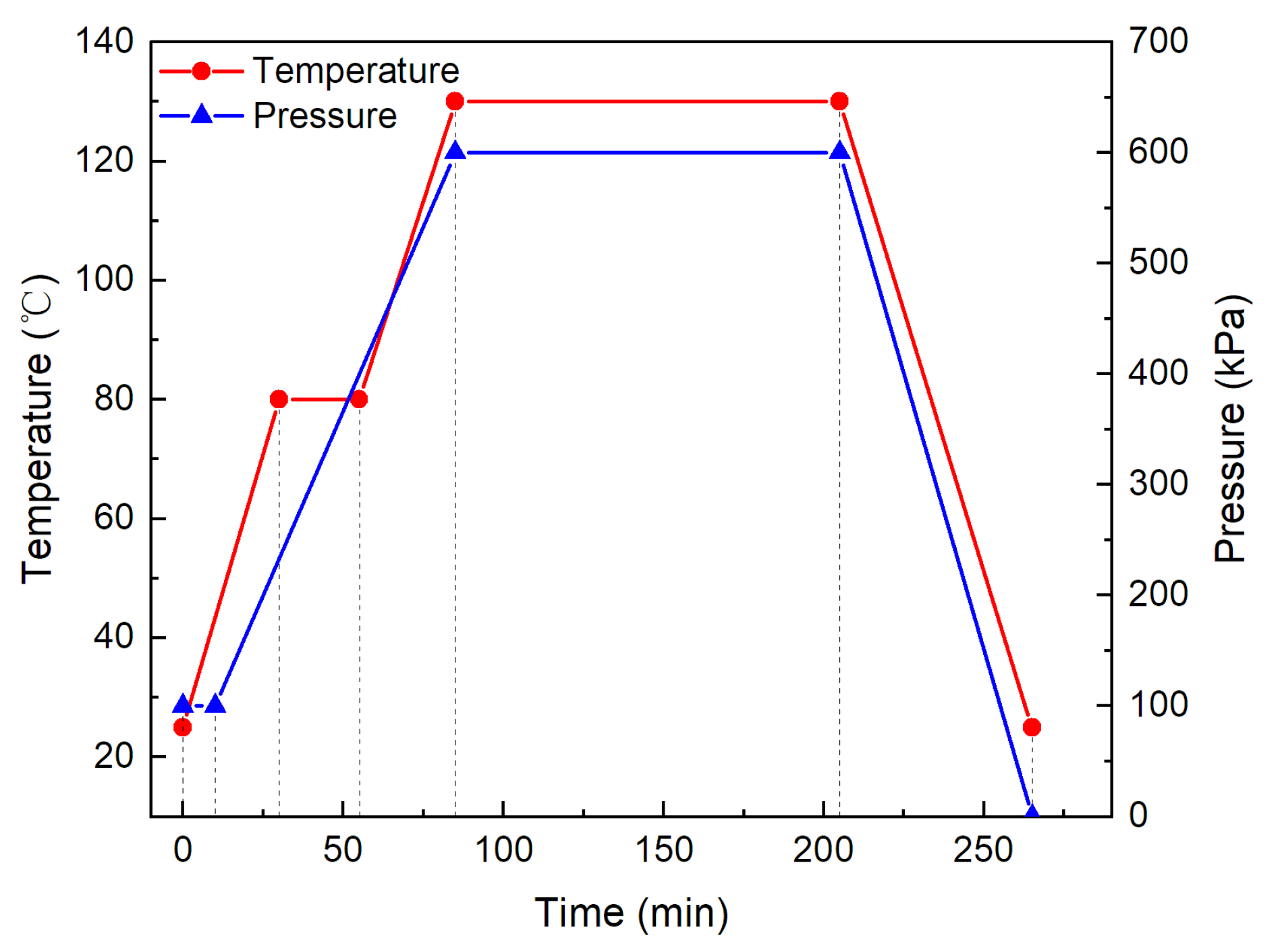
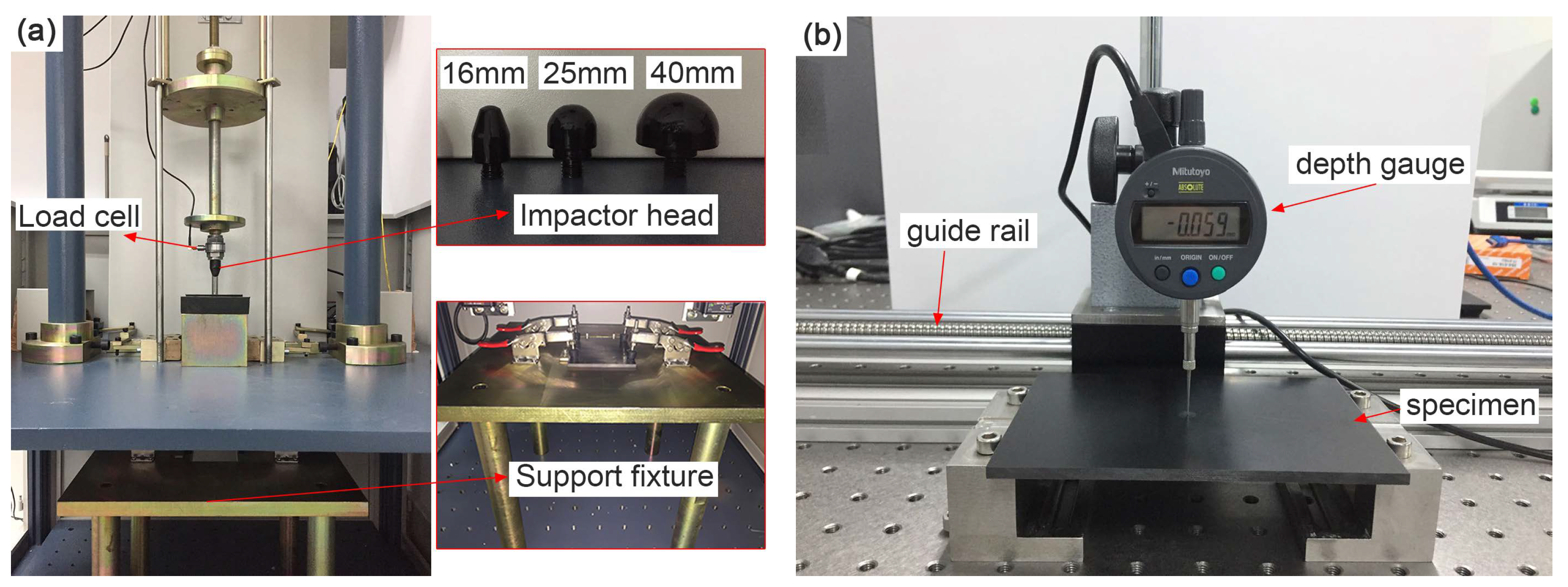
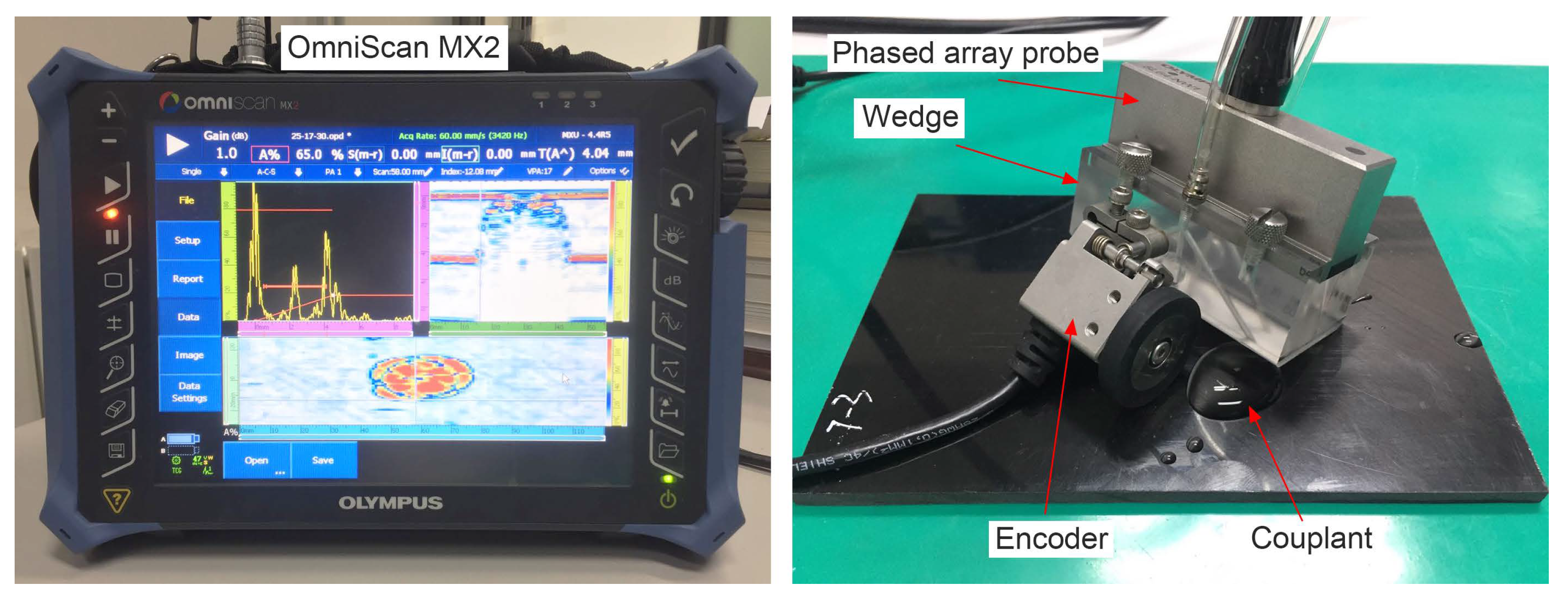
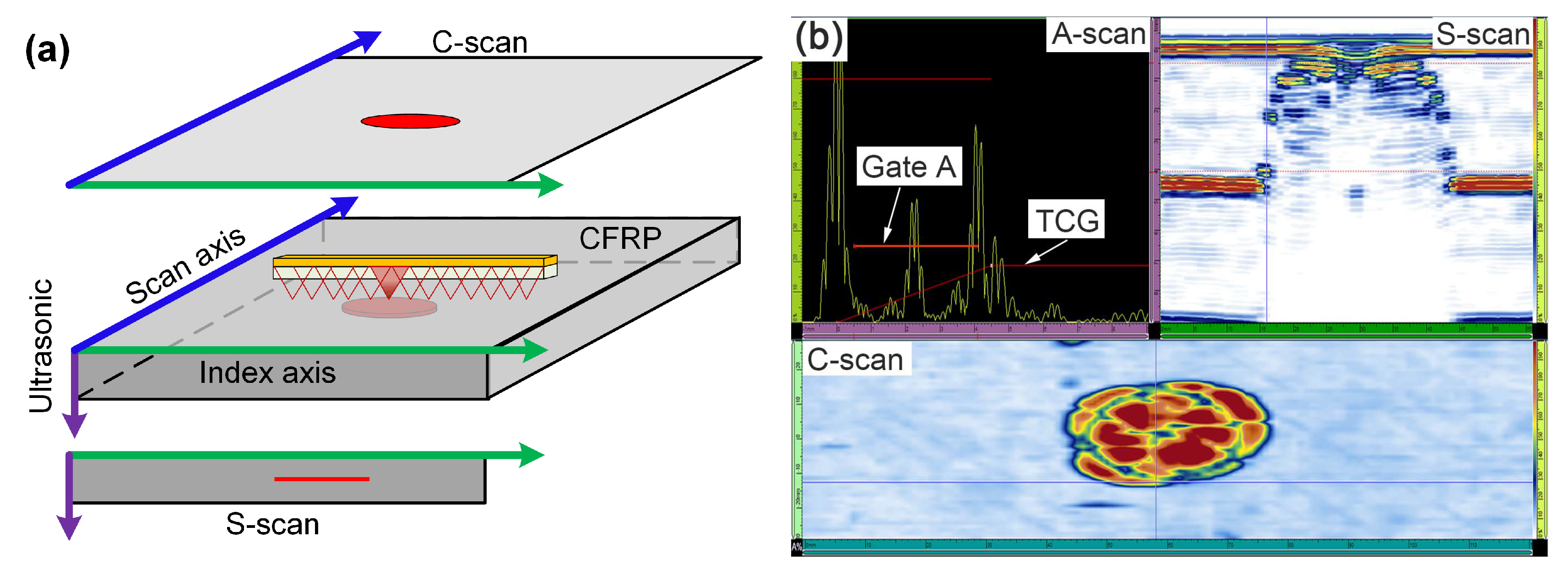
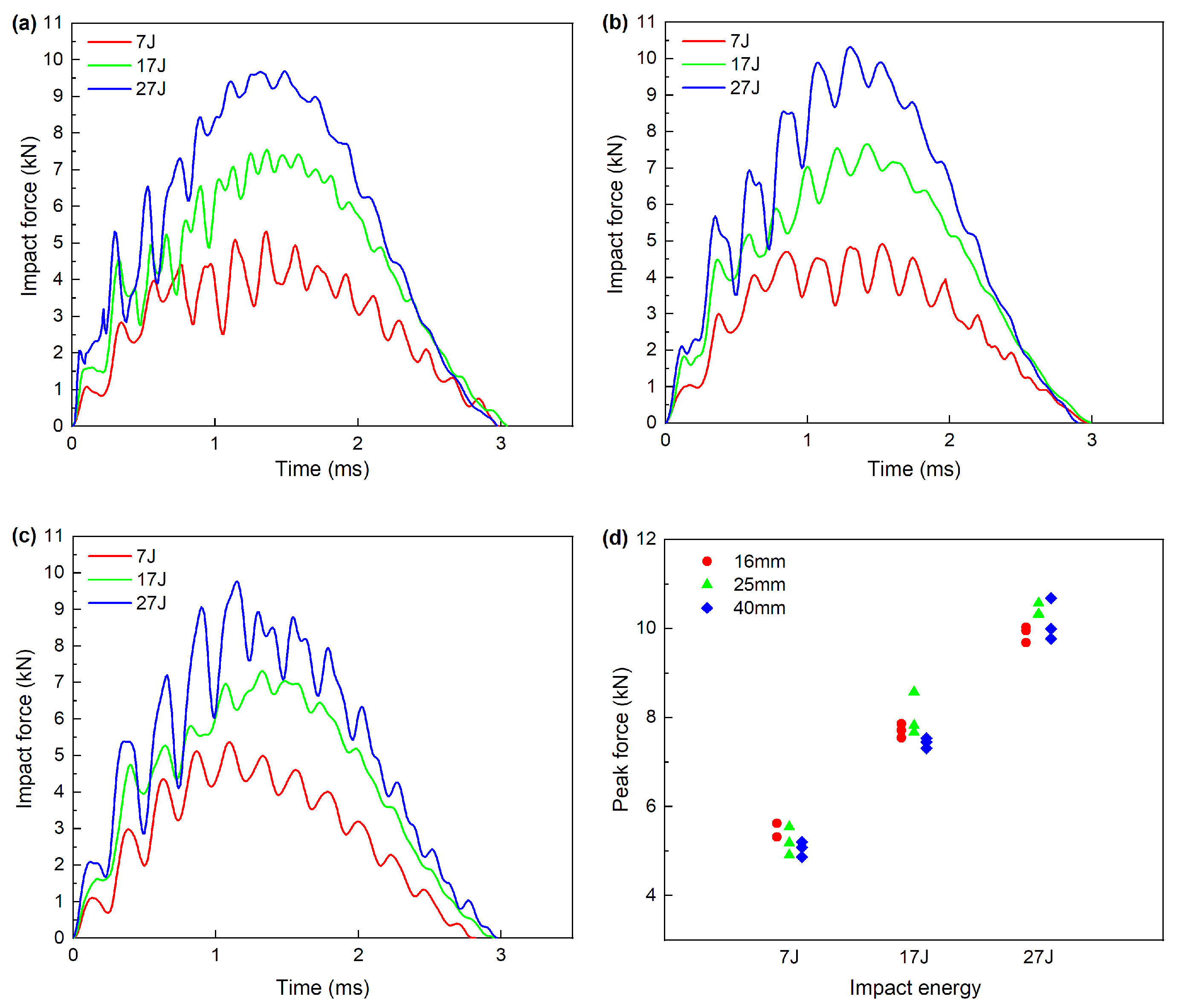
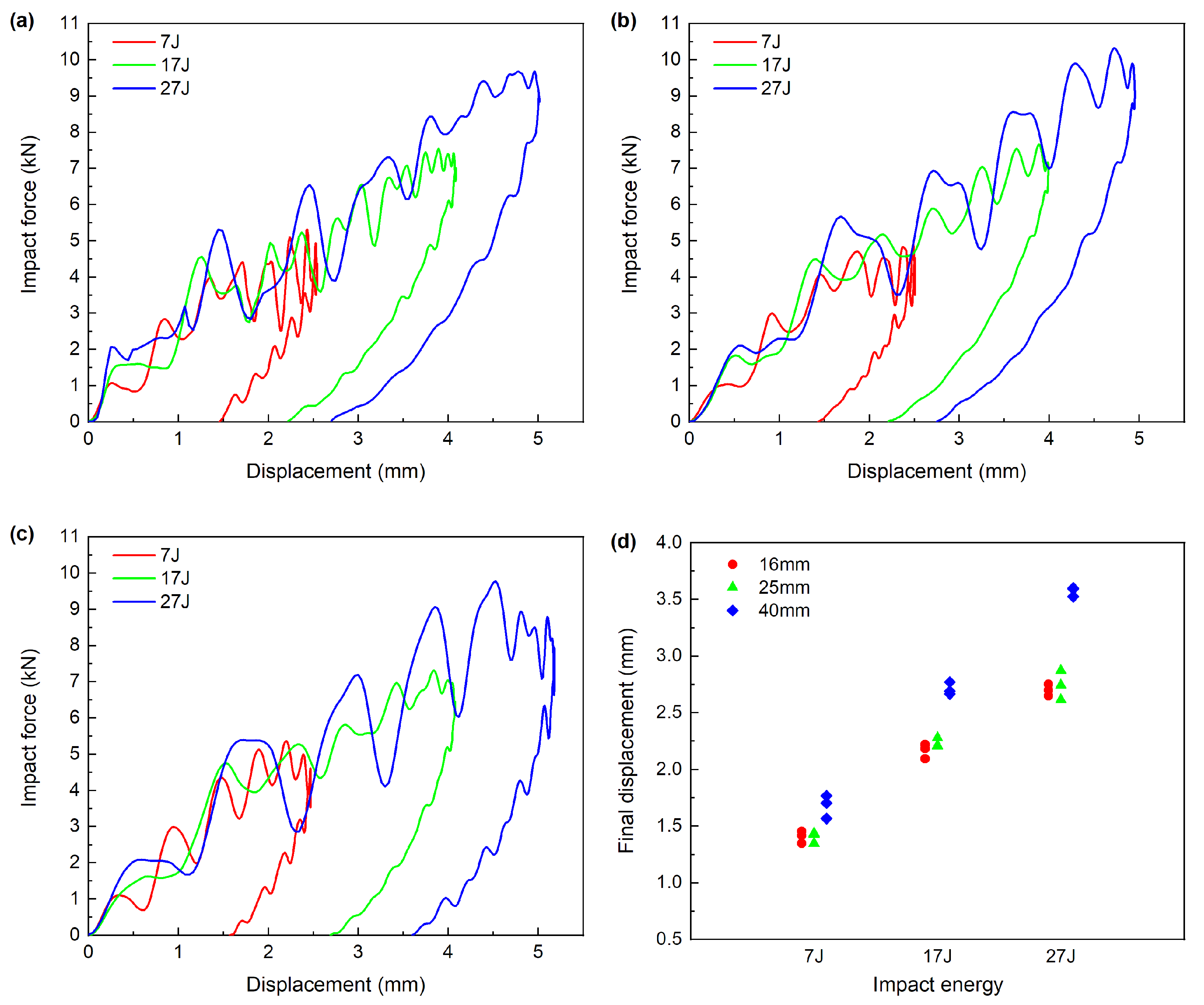
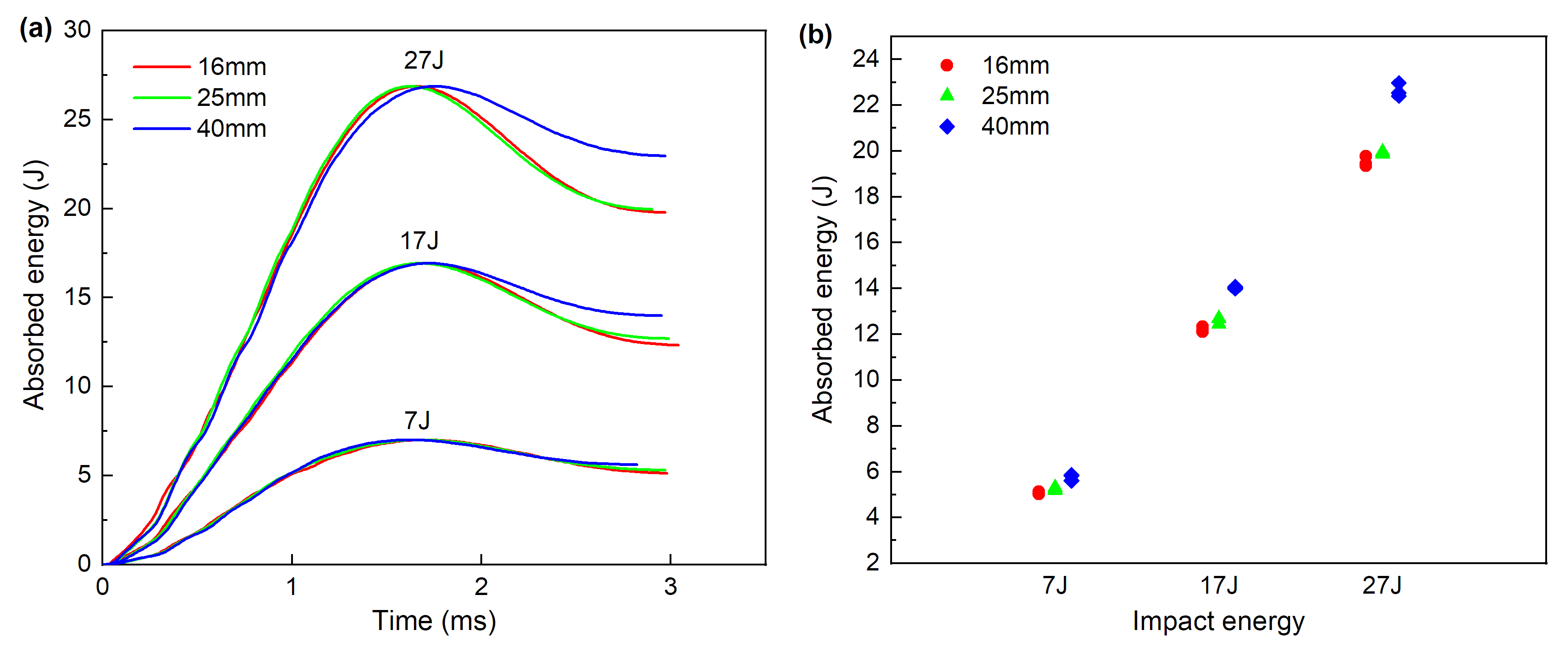
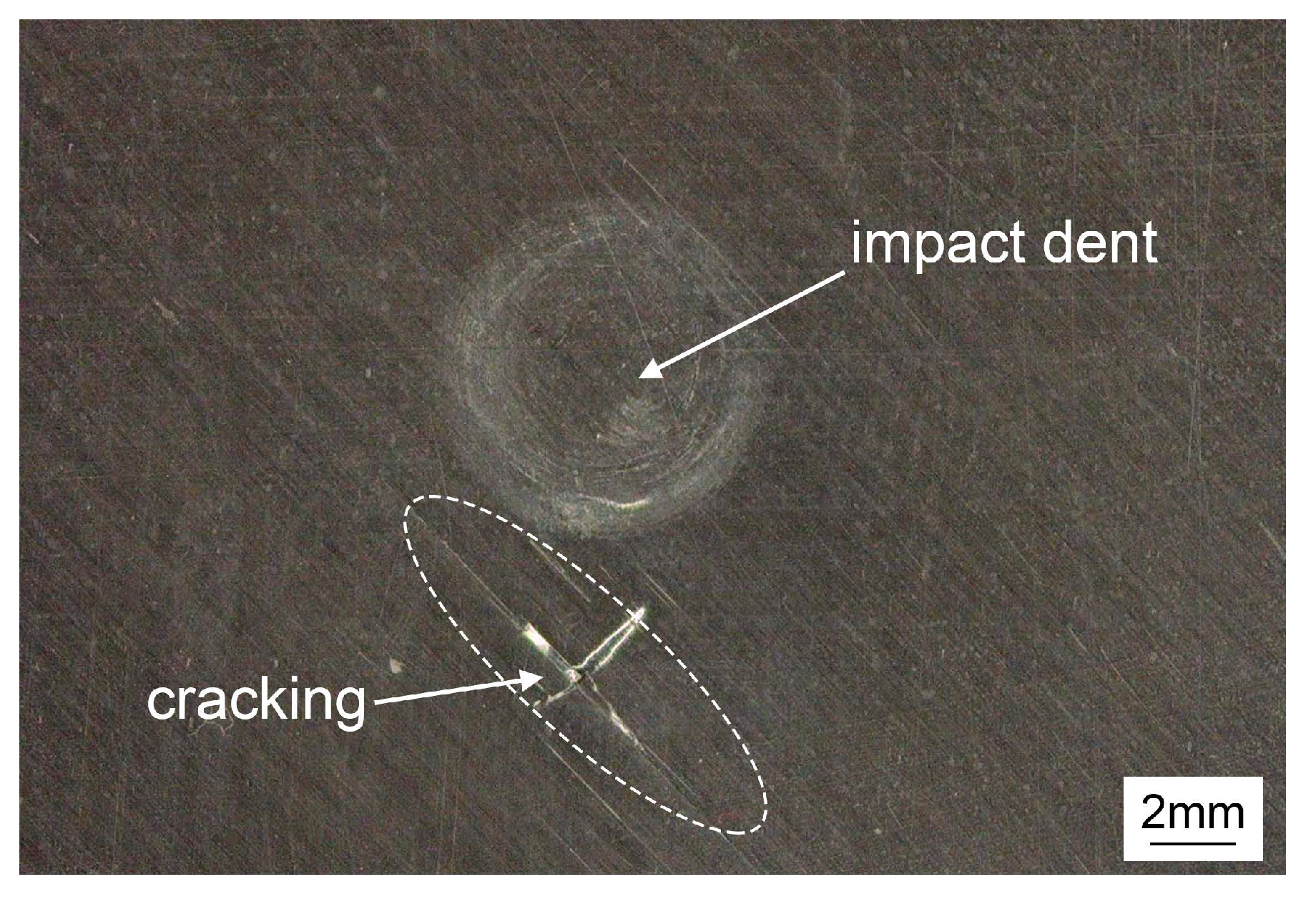
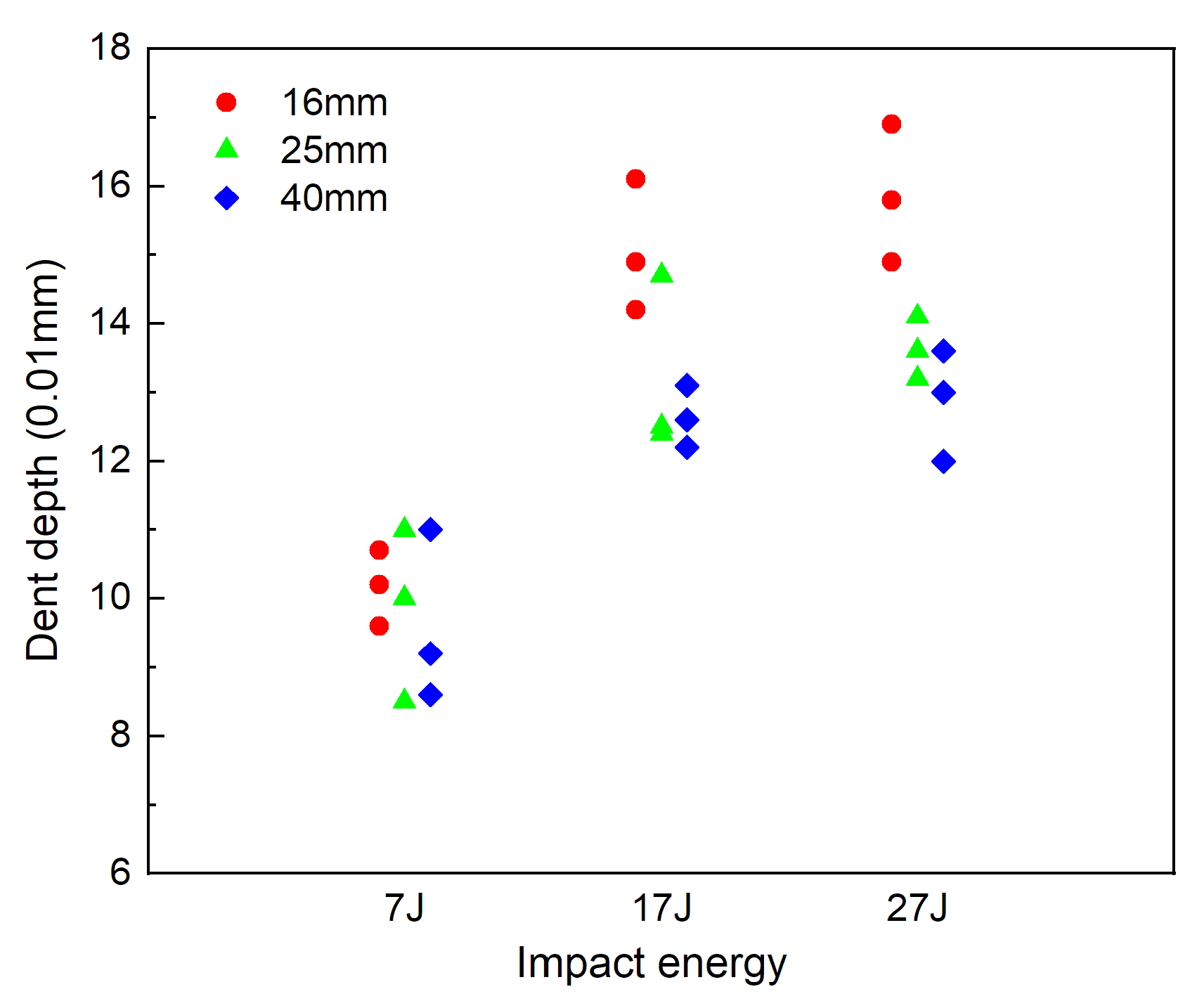

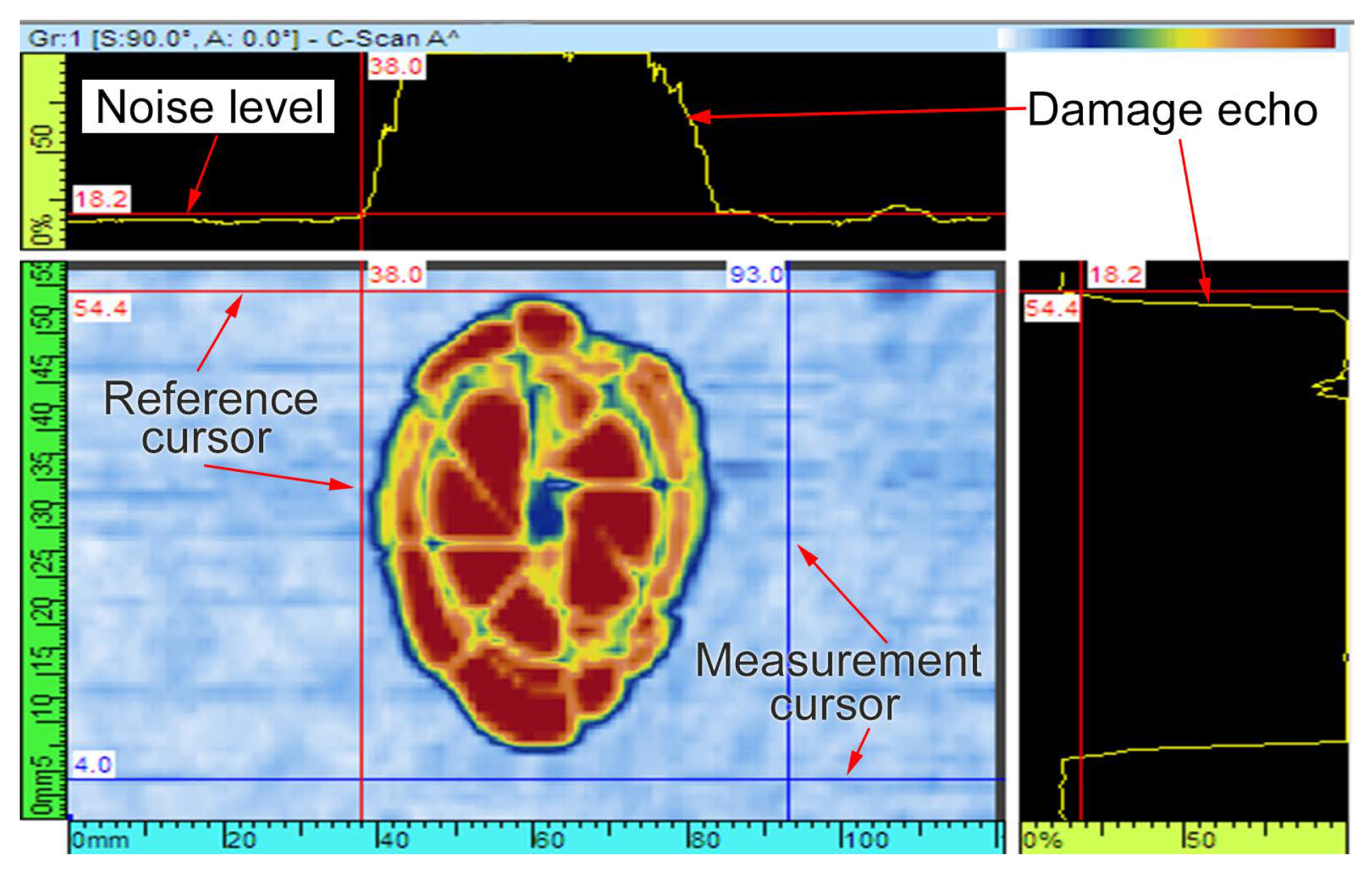
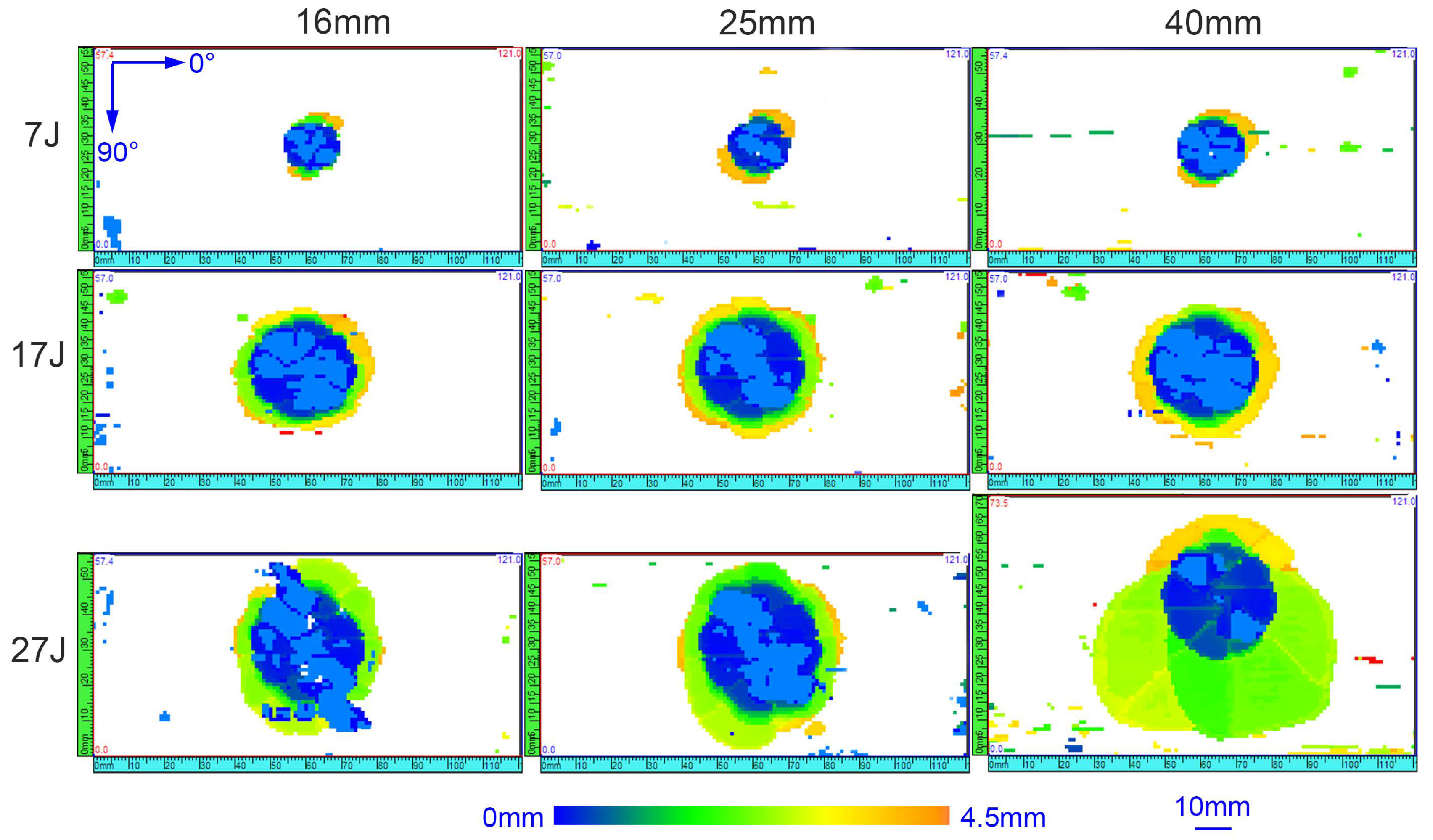
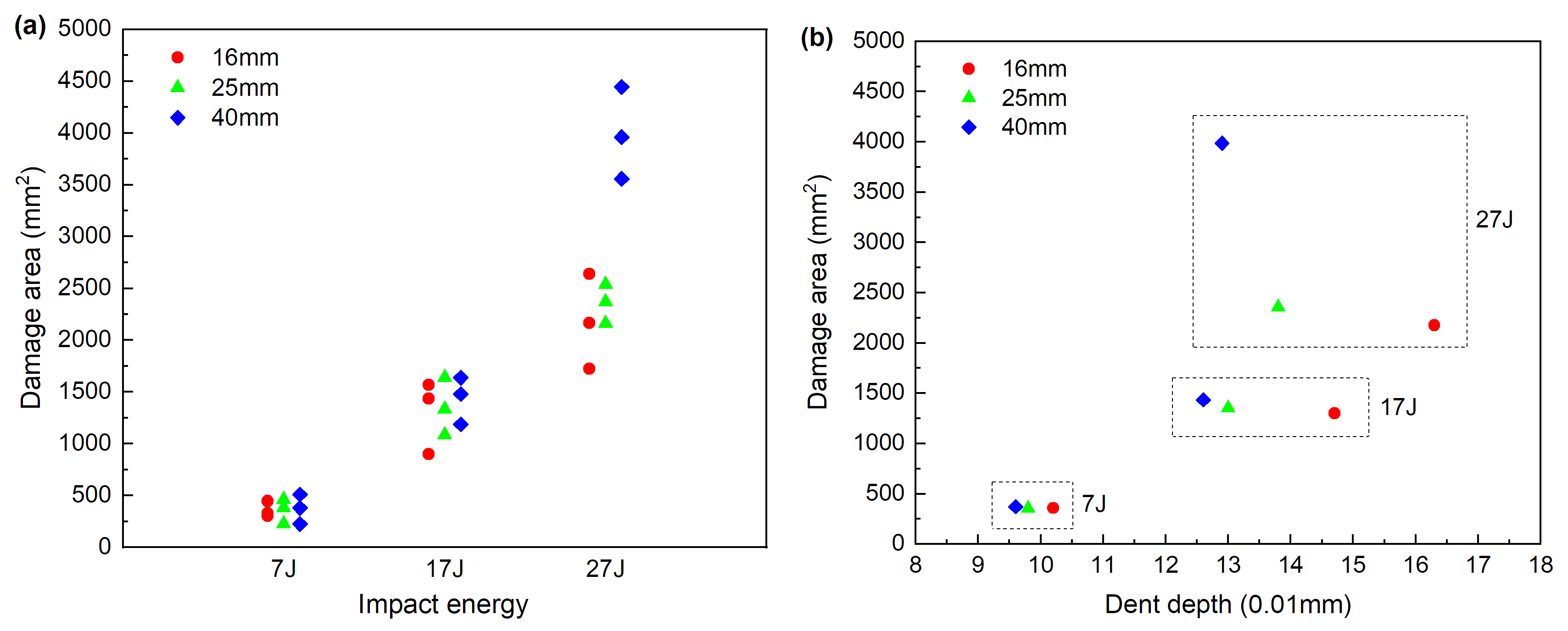
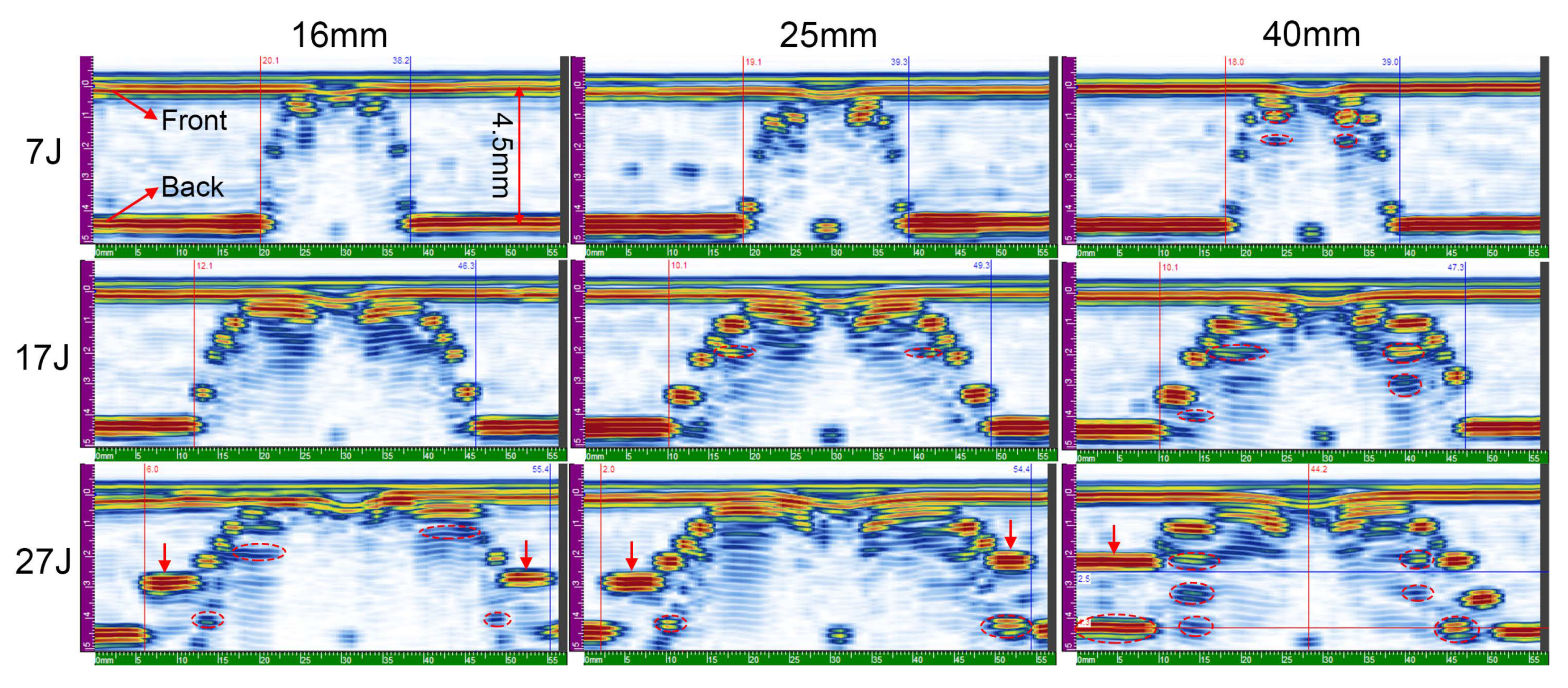
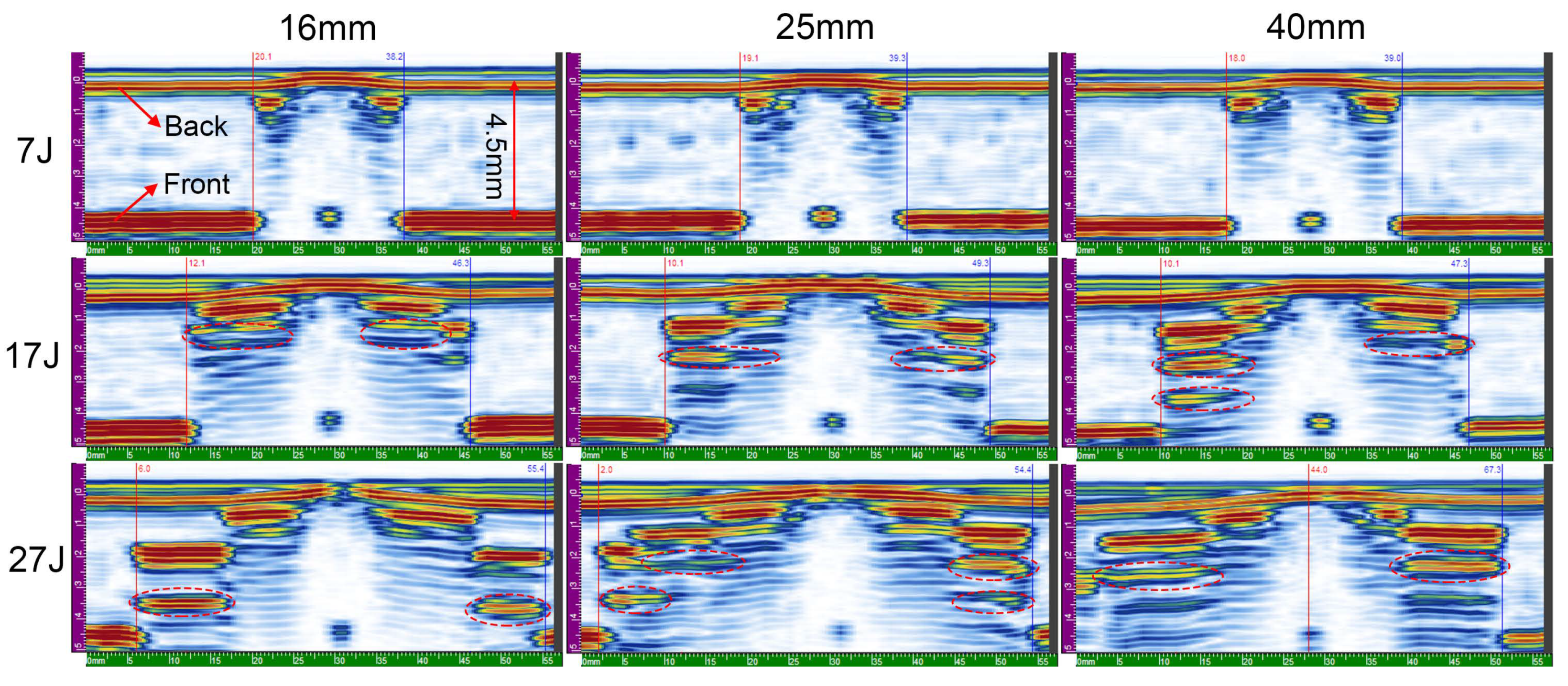


| E (GPa) | E (GPa) | G (GPa) | (MPa) | (MPa) | (MPa) | (MPa) | (MPa) | |
|---|---|---|---|---|---|---|---|---|
| 140 | 9 | 4.6 | 70 | 0.32 | 1760 | 51 | 1100 | 130 |
© 2020 by the authors. Licensee MDPI, Basel, Switzerland. This article is an open access article distributed under the terms and conditions of the Creative Commons Attribution (CC BY) license (http://creativecommons.org/licenses/by/4.0/).
Share and Cite
Cao, H.; Ma, M.; Jiang, M.; Sun, L.; Zhang, L.; Jia, L.; Tian, A.; Liang, J. Experimental Investigation of Impactor Diameter Effect on Low-Velocity Impact Response of CFRP Laminates in a Drop-Weight Impact Event. Materials 2020, 13, 4131. https://doi.org/10.3390/ma13184131
Cao H, Ma M, Jiang M, Sun L, Zhang L, Jia L, Tian A, Liang J. Experimental Investigation of Impactor Diameter Effect on Low-Velocity Impact Response of CFRP Laminates in a Drop-Weight Impact Event. Materials. 2020; 13(18):4131. https://doi.org/10.3390/ma13184131
Chicago/Turabian StyleCao, Hongyi, Mengyuan Ma, Mingshun Jiang, Lin Sun, Lei Zhang, Lei Jia, Aiqin Tian, and Jianying Liang. 2020. "Experimental Investigation of Impactor Diameter Effect on Low-Velocity Impact Response of CFRP Laminates in a Drop-Weight Impact Event" Materials 13, no. 18: 4131. https://doi.org/10.3390/ma13184131
APA StyleCao, H., Ma, M., Jiang, M., Sun, L., Zhang, L., Jia, L., Tian, A., & Liang, J. (2020). Experimental Investigation of Impactor Diameter Effect on Low-Velocity Impact Response of CFRP Laminates in a Drop-Weight Impact Event. Materials, 13(18), 4131. https://doi.org/10.3390/ma13184131






